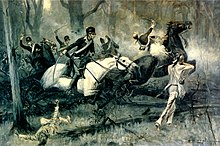List of wars involving the United States
This is a list of wars involving the United States of America.[1]
- USA defeat
- USA victory
- Another result (e.g. a treaty or peace without a clear result, status quo ante bellum, result of civil or internal conflict, result unknown or indecisive)
- Ongoing conflict
18th-century wars[change | change source]
19th-century wars[change | change source]
| Conflict | Allies | Belligerent | Result for the United States and its Allies | Presidents of the United States |
|---|---|---|---|---|
| First Barbary War (1801–1805) Part of the Barbary Wars Location: Mediterranean Sea off the coast of Tripoli  |
US-allied victory | Thomas Jefferson | ||
| Tecumseh's War (1810–1813) Part of the American Indian Wars and the War of 1812 Location: Northwest River Ohio  |
Tecumseh's Confederacy
List |
US victory | James Madison | |
| War of 1812 (1812–1815) Location: Eastern and Central North America  |
Creek Allies |
List |
Inconclusive/Other Result
| |
| Creek War (1813–1814) Part of the American Indian Wars and the War of 1812 Location: Southern United States  |
Lower Creeks |
Red Stick Creek | US-allied victory | |
| Second Barbary War (1815) Part of the Barbary Wars Location: Mediterranean Sea and the Barbary States 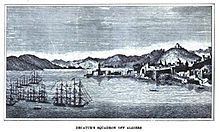 |
US victory | |||
| First Seminole War (1817–1818) Part of the Seminole Wars and the American Indian Wars Location: Pensacola, Spanish Florida  |
Seminole
|
US victory
|
James Monroe | |
| Arikara War (1823) Part of the American Indian Wars Location: Missouri River 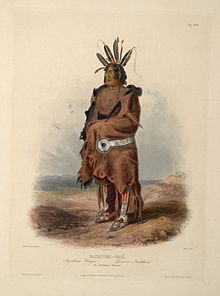 |
Arikara | Inconclusive/Other Result
| ||
| Winnebago War (1827) Part of the American Indian Wars Location: Illinois and Michigan Territory |
Prairie La Crosse Ho-Chunks with a few allies |
US-allied victory
|
John Quincy Adams | |
| Black Hawk War (1832) Part of the American Indian Wars Location: Illinois and Michigan Territory  |
Ho-Chunk Menominee Potawatomi |
Black Hawk's British Band Ho-Chunk and Potawatomi allies |
US-allied victory
|
Andrew Jackson |
| Texas Revolution (1835–1836) Location: Texas  |
Texan victory
|
Martin Van Buren | ||
| Second Seminole War (1835–1842) Part of the Seminole Wars and the American Indian Wars Location: Florida, United States  |
Seminole | US victory
|
Martin Van Buren (March 4, 1837 – March 4, 1841)
William Henry Harrison(March 4, 1841 – April 4, 1841) John Tyler (April 4, 1841 –March 4, 1845) | |
| Aroostook War (1838–1839) Location: Maine–New Brunswick border  |
[[File:|23x15px|border |alt=|link=]] United Kingdom [[File:|23x15px|border |alt=|link=]] British America |
Inconclusive/Other Result | Martin Van Buren | |
| Mexican–American War (1846–1848) Location: Texas, New Mexico, California and Mexico  |
US-allied victory
|
James K. Polk | ||
| Cayuse War (1847–1855) Part of the American Indian Wars Location: Oregon 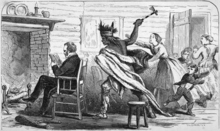 |
Cayuse | US victory
|
James K. Polk (March 4, 1845 – March 4, 1849)
Zachary Taylor (March 4, 1849 – July 9, 1850) Millard Fillmore (July 9, 1850 – March 4, 1853) Franklin Pierce (March 4, 1853 – March 4, 1857) | |
| Apache Wars (1849–1924) Part of the Texas–Indian wars and the American Indian Wars Location: Southwestern United States  |
Apache Ute Yavapai |
US victory
|
James K. Polk (March 4, 1845 – March 4, 1849)
Zachary Taylor (March 4, 1849 – July 9, 1850) Millard Fillmore (July 9, 1850 – March 4, 1853) Franklin Pierce (March 4, 1853 – March 4, 1857) James Buchanan (March 4, 1857 – March 4, 1861) Abraham Lincoln (March 4, 1861 – April 15, 1865) Andrew Johnson (April 15, 1865 – March 4, 1869) Ulysses S. Grant (March 4, 1869 – March 4, 1877) Rutherford B. Hayes (March 4, 1877 – March 4, 1881) James A. Garfield (March 4, 1881 – September 19, 1881) Chester A. Arthur (September 19, 1881 – March 4, 1885) Grover Cleveland (March 4, 1885 – March 4, 1889) Benjamin Harrison (March 4, 1889 – March 4, 1893) Grover Cleveland (March 4, 1893 – March 4, 1897) William McKinley (March 4, 1897 – September 14, 1901) Theodore Roosevelt (September 14, 1901 – March 4, 1909) William Howard Taft (March 4, 1909 – March 4, 1913) Woodrow Wilson (March 4, 1913 – March 4, 1921) Warren G. Harding (March 4, 1921 – August 2, 1923) Calvin Coolidge (August 2, 1923 – March 4, 1929) | |
| Bleeding Kansas (1854–1861) Location: Kansas and Missouri 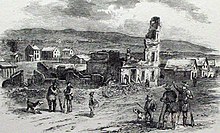 |
Anti-slavery settlers (Free-Staters) |
Pro-slavery settlers (Border Ruffians) | Free-Stater victory.
|
Franklin Pierce (March 4, 1853 – March 4, 1857)
James Buchanan (March 4, 1857 – March 4, 1861) |
| Puget Sound War (1855–1856) Part of the American Indian Wars Location: Washington |
Snoqualmie |
Nisqually Muckleshoot Puyallup Klickitat Haida Tlingit |
US victory | Franklin Pierce |
| Rogue River Wars (1855–1856) Location: Rogue Valley |
Rogue River people | US victory
| ||
| Third Seminole War (1855–1858) Part of the Seminole Wars and the American Indian Wars Location: Pensacola, Florida |
Seminole | US victory
|
Franklin Pierce (March 4, 1853 – March 4, 1857)
James Buchanan (March 4, 1857 – March 4, 1861) | |
| Yakima War (1855–1858) Part of the American Indian Wars Location: Washington Territory  |
Snoqualmie |
Yakama Walla Walla tribe Umatilla tribe Nez Perce tribe Cayuse tribe |
US victory | Franklin Pierce (March 4, 1853 – March 4, 1857)
James Buchanan (March 4, 1857 – March 4, 1861) |
| Second Opium War (1856–1859) Part of the Opium Wars Location: China  |
US victory
|
Franklin Pierce (March 4, 1853 – March 4, 1857)
James Buchanan (March 4, 1857 – March 4, 1861) | ||
| Utah War (1857–1858) Part of the Mormon wars Location: Utah Territory and Wyoming |
Deseret/Utah Mormons (Nauvoo Legion) | Inconclusive/Other Result
|
Franklin Pierce (March 4, 1853 – March 4, 1857)
James Buchanan (March 4, 1857 – March 4, 1861) | |
| Navajo Wars (1858–1866) Part of the American Indian Wars Location: New Mexico 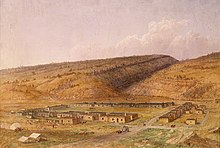 |
US victory
|
Franklin Pierce (March 4, 1853 – March 4, 1857)
James Buchanan (March 4, 1857 – March 4, 1861) Abraham Lincoln (March 4, 1861 – April 15, 1865) | ||
| Pig War (1859) Location: San Juan Islands 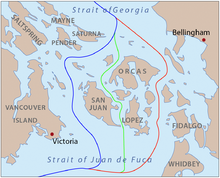 Proposed boundaries: Through Haro Strait, favored by the US Through Rosario Strait, favored by Britain Through San Juan Channel, compromise proposal The lines are as shown on maps of the time. The modern boundary follows straight line segments and roughly follows the blue line. The modern eastern boundary of San Juan County roughly follows the red line. |
Inconclusive
|
James Buchanan | ||
| John Brown's Raid on Harpers Ferry (1859) Part of pre-Civil War conflicts Location: West Virginia  |
Abolitionist Insurgents | US victory | James Buchanan | |
| First and Second Cortina War (1859–1861) Location: Texas and Mexico |
US-allied victory | James Buchanan | ||
| Paiute War (1860) Part of the American Indian Wars Location: Pyramid Lake, Nevada |
Paiute Shoshone Bannock |
US victory | James Buchanan | |
| American Civil War (1861–1865) Location: Southern United States, Indian Territory, Northeastern United States, Western United States, Atlantic Ocean  |
Indian Home Guard |
Catawba |
US victory
|
|
| Yavapai Wars (1861–1875) Part of the American Indian Wars Location: Arizona  |
Yavapai Apache Yuma Mohave |
US victory |
Abraham Lincoln (March 4, 1861 – April 15, 1865) Andrew Johnson (April 15, 1865 – March 4, 1869) Ulysses S. Grant (March 4, 1869 – March 4, 1877) | |
| Dakota War of 1862 (1862) Part of the American Indian Wars Location: Minnesota and Dakota  |
US victory | Abraham Lincoln | ||
| Colorado War (1863–1865) Part of the American Indian Wars Location: Colorado, Wyoming, and Nebraska |
Inconclusive/Other Result
| |||
| Snake War (1864–1868) Part of the American Indian Wars Locations: Oregon, Nevada, California, and Idaho |
Paiute Bannock Shoshone |
US victory | Abraham Lincoln (March 4, 1861 – April 15, 1865)
Andrew Johnson (April 15, 1865 – March 4, 1869) | |
| Powder River War (1865) Part of the American Indian Wars Location: Powder River State |
Inconclusive | |||
| Red Cloud's War (1866–1868) Part of the American Indian Wars Location: Powder River State  |
Lakota-allied victory
| |||
| Comanche Campaign (1867–1875) Part of the American Indian Wars Location: Western United States  |
Kiowa |
US victory | Andrew Johnson (April 15, 1865 – March 4, 1869)
Ulysses S. Grant (March 4, 1869 – March 4, 1877) | |
| United States expedition to Korea
(1871) Location: Ganghwa Island |
Inconclusive/Other Result
American military victory American diplomatic failure
|
Ulysses S. Grant | ||
| Modoc War (1872–1873) Part of the American Indian Wars Location: California and Oregon  |
US victory | |||
| Red River War (1874–1875) Part of the American Indian Wars Location: Texas |
Kiowa |
US victory
| ||
| Las Cuevas War (1875) Location: Texas and Mexico 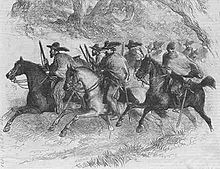 |
Mexican bandits | US victory
| ||
| Great Sioux War of 1876 (1876–1877) Part of the American Indian Wars Location: Montana, Dakota and Wyoming  |
US victory
| |||
| Buffalo Hunters' War (1876–1877) Part of the American Indian Wars Location: Texas and Oklahoma |
Apache |
US victory | ||
| Nez Perce War (1877) Part of the American Indian Wars Location: Oregon, Idaho, Wyoming, and Montana  |
Nez Perce Palouse |
US victory | Rutherford B. Hayes | |
| Bannock War (1878) Part of the American Indian Wars Location: Idaho, Oregon, and Wyoming |
Bannock Shoshone Paiute |
US victory | ||
| Cheyenne War (1878–1879) Part of the American Indian Wars Location: Oklahoma, Kansas, Nebraska, South Dakota and Montana |
US victory | |||
| Sheepeater Indian War (1879) Part of the American Indian Wars Location: Idaho |
Shoshone | US victory | ||
| Victorio's War (1879–1880) Part of the American Indian Wars Location: Mexico |
Apache | US-allied victory | ||
| White River War (1879) Part of the American Indian Wars Location: Colorado  |
Ute | US victory | ||
| Crow War (1887) Part of the American Indian Wars Location: Montana  |
US victory | Grover Cleveland | ||
| Pine Ridge Campaign (1890–1891) Part of the American Indian Wars Location: South Dakota  |
US victory | Benjamin Harrison | ||
| Garza War (1891–1893) Location: Texas and Mexico  |
Garzistas | US-allied victory | ||
| Yaqui Wars (1896–1918) Part of the American Indian Wars Location: Arizona and Mexico |
Pima Opata |
US-allied victory | Grover Cleveland (March 4, 1893 – March 4, 1897)
| |
| Second Samoan Civil War (1898–1899) Location: Samoa  |
Samoa |
Mataafans |
Inconclusive/Other Result
|
William McKinley |
| Spanish–American War (1898) Location: Cuba, Puerto Rico, Philippines and Guam 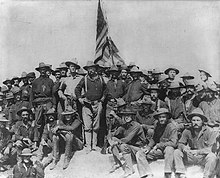 |
US-allied victory
|
William McKinley | ||
| Philippine–American War (1899–1902) Location: Philippines  |
1899–1902 1902-1906 |
1899–1902 Limited Foreign Support: 1902-1906 |
US victory
|
William McKinley (March 4, 1897 – September 14, 1901)
|
| Moro Rebellion (1899–1913) Location: Philippines 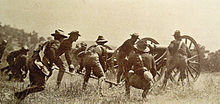 |
US victory
|
William McKinley (March 4, 1897 – September 14, 1901)
| ||
| Boxer Rebellion (1899–1901) Location: China  |
|
US-allied victory
|
William McKinley | |
| Vietnam War (1955–1975) Location: Vietnam, Laos, Cambodia  |
Vietnam victory
|
Richard Nixon |
Related pages[change | change source]
Notes[change | change source]
- ↑ These numbers are gathered from a combination of surviving muster rolls and veteran applications for land grants. It is likely that the statistics on the Texan army size in both 1835 and 1836 underestimate the number of Tejanos who served in the army. American volunteers who returned to the U.S. without claiming land are also undercounted. Lack (1992), p. 113.
References[change | change source]
- ↑ Kelly, Martin (4 November 2020). "American Involvement in Wars From Colonial Times to the Present". ThoughtCo. Retrieved 31 January 2022.
- ↑ 2.0 2.1 2.2 2.3 2.4 2.5 "Tripolitan War | Encyclopedia.com". www.encyclopedia.com. Retrieved May 8, 2019.
- ↑ 3.0 3.1 r2WPadmin. "First Barbary War". American History Central. Retrieved May 8, 2019.
{{cite web}}: CS1 maint: numeric names: authors list (link) - ↑ Serial 89, 18th Congress, 1st Session, Senate Document No. 1, p. 95
- ↑ Lack (1992), pp. 122–3.
- ↑ "The Indians". The Philadelphia Inquirer. November 12, 1884.
- ↑ "Union and Confederate Indians in the Civil War". civilwarhome.com. 2002-02-16. Archived from the original on February 13, 2021. Retrieved December 12, 2021.
Other websites[change | change source]
- Heidelberg Institute for International Conflict Research (HIIK)
- Conflict Barometer – Describes recent trends in conflict development, escalations, and settlements
- A Continent Divided: The U.S.-Mexico War[permanent dead link], Center for Greater Southwestern Studies, the University of Texas at Arlington
- Timeline of wars involving the United States, Histropedia
- U.S. Periods of War and Dates of Recent Conflicts, Congressional Research Service



